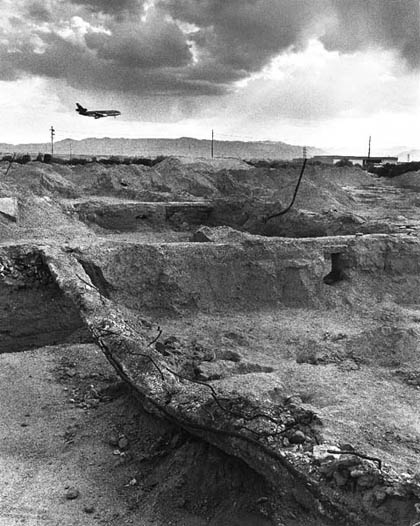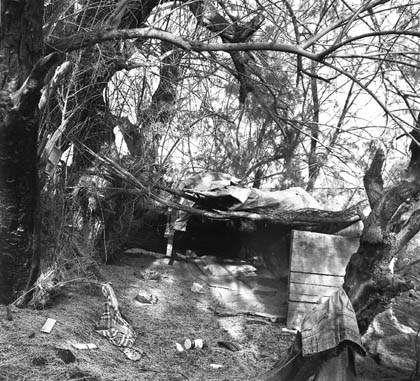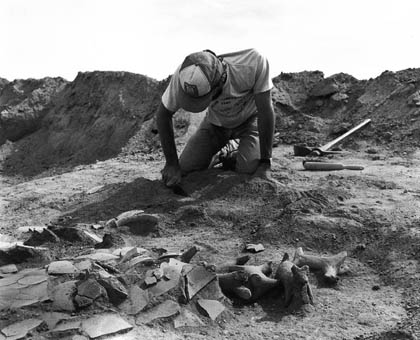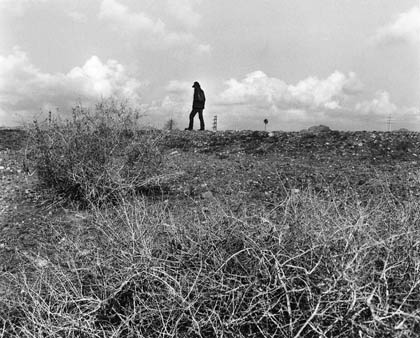For more than a year, I traveled to Phoenix to roam around Pueblo Grande and its environs, photographing the multiple layers of culture in evidence. I watched the smoke-belching machines churn the earth while trucks and cars rumbled and honked in the nearby traffic-clogged streets and freight trains crawled toward downtown. Adding to the scene, passenger jets roared off the east end of the Sky Harbor International Airport's busy runway. Planes, trains, cars, trucks, bulldozers, road graders together produced a veritable cacophony that mixed with blowing dust and burning heat. The experience brought to mind scenes from post-cataclysm science fiction films. It was a photographer's dream and nightmare.
In the middle of all the chaos lay open areas in which the foundations of old Phoenix industrial buildings twisted in the pain of demolition; beneath them were the ruins of Pueblo Grande, which had lain dormant for eight hundred years. Among the adobe walls and floors, archaeologists kneeled, heads bent over their trowels and brushes. With methodical care, they brought into the light the trodden floors and stone hearths, the ceramic cooking pots and bone awls, the necklaces and the toys of the children.
A city park -- the Park of the Four Waters -- was located near the archaeological excavations and within the limits of the Pueblo Grande community. At that time, the place was a trashy and wild chunk of real estate, virtually ignored by the city and inhabited by vagrants. Phoenicians did not have Sunday picnics in this park.
I regarded it as a kind of living archaeological site and spent many hours making pictures of the accumulating detritus -- artifacts, if you will -- that littered the landscape. I found chipped-stone flakes scattered among plastic rings, broken dolls, and machine parts. The pages of racy magazines and tabloids, crisped and warped by the weather, flapped in the wind beside centuries-old pottery sherds. A pile of railroad spikes, the skeleton of a bird, a battered and stained copy of the Arabian Nights: everything was there.
In addition to the evolving middens, there were the camps of the homeless. Some consisted of no more than a body-size sleeping place next to a fireplace of river cobbles, but park residents had developed others into more permanent dwellings with homelike enhancements: a canvas fly, worn easy chair, sleeping nook with a mattress, and kitchen complete with cooking utensils and plastic dinnerware.
One early morning I walked farther into the park, beyond the main concentration of camps and across the railroad tracks. The end of Sky Harbor Airport's main runway was only a few yards away. There I found a broad, deep prehistoric canal and in it an isolated encampment in the shade of a tree. Its occupant had nailed a sheet of rough plywood to the tree to form one side. Another sheet, brightly decorated with stars, formed the back. A propped-up, slatted fence served as a third wall. Whoever lived there had dug a square fire pit and lined it with cement blocks. To one side, recessed under spreading branches, he had laid down his mattress.
I approached slowly, coughed to signal my presence, and concluded no one was home. When I moved closer and set up my camera, however, I discovered a large rattlesnake asleep in the hearth. I framed a picture and adjusted the settings. Just then I heard the deafening roar of a jet coming down the runway. When it rose over the tree, I depressed the cable release.
As time passed and I grew more familiar with the park, I began no longer to regard its occupants as "vagrants"or "homeless." Clearly this was their home. I saw them instead as members of an American subculture, a group of people continuing an age-old tradition of semi-nomadism, foraging, and making do with a minimum of material possessions. Their way of life and means of survival had defined our species for untold generations. Although these were solitary folk, I felt that they, too, were the descendants of the Hohokam.
PAGE 1 PAGE 2 PAGE 3 *PAGE 4* COVER PAGE
click image to enlarge



